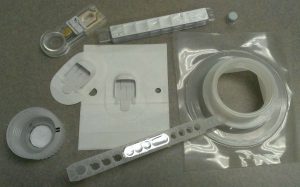Laser Welding vs. Heat Staking for Medical Part Assembly

In medical part assembly, manufacturers need to join thermoplastics in a consistent, reliable way that produces no flash or particulate during the process. In the world of plastic assembly, two of the best options for precision assembly are laser welding and heat staking.
- Heat Staking uses heat and pressure to deform a protruding plastic stud to retain or clamp an assembly or components together. The application of heat and pressure ensures that the plastic liquefies and then hardens (melts and resets) in the exact form or shape required to create the strongest possible bond.
- Laser Welding creates precise plastic bonds by heating the conjoining elements with a laser. Because the laser is very precise, manufacturers can create intricate bonds while generating no flash or particulate matter. Lasers also work very quickly, but are expensive and difficult to calibrate.
Special Assembly Concerns for Medical Components
Unlike friction-based joining processes like ultrasonic, vibration and spin welding, heat staking and laser welding generate no particulates. This represents an enormous advantage for medical device manufacturers that must maintain a high level of purity during the assembly processes.
For instance, the plastic fluid channels inside a blood test device may be a single millimeter wide. If plastic contaminants smaller than one millimeter accidentally make their way into the fluid channels, people may get false positives on their bloodwork.
For this reason, plastics manufacturers need to rely on particulate-free assembly processes like heat staking and laser welding. Each one carries its own set of benefits and drawbacks, as outlined below.
Laser Welding Pros and Cons
By relying on custom-made waveguides that indicate where the laser will activate, laser welding produces extraordinarily clean and precise bonds. Additionally, it can weld almost any elastomer or thermoplastic, including high-density polyethylene that typically responds poorly to ultrasonic welding. Laser welding is very good at making hermetic seals in microfluidic devices.
The drawback to laser welding is that the equipment is expensive. Laser devices not only cost tens of thousands of dollars to purchase, but only specialized technicians can operate, maintain, and calibrate them. This makes laser welding an option only for medical device manufacturers with customers willing to pay top-dollar for their products.
Heat Staking Pros and Cons
Heat staking machines are far more affordable than laser welding equipment. They are also much easier to calibrate and maintain, as well as much faster to tooling changeovers, offering more time-efficient and scalability into the equipment comparisons. A high quality thermal press can perform heat staking simultaneously on multiple planes and at multiple points, as well as be used for any other applications requiring precise heat, pressure and/or motion control.
Low quality heat staking machines can produce problems, however. Materials with a narrow melt range may be scorched or damaged by thermal presses that do not have a very tightly controlled heating system. Also, cycle times are not nearly as fast compared to laser welding – but the ability to quickly switch out toolkits compensates for this fact, since lasers take a very long time to calibrate for individual jobs.